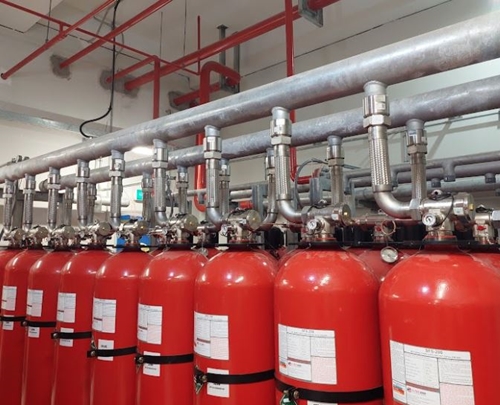HFC-227EA (FM-200) GAS FIRE SUPPRESSION SYSTEM
Nowadays, fire prevention is a critical concern for both businesses and households. Modern fire protection systems, designed to safeguard lives and property digitally, are increasingly prevalent. S-TEC VINA offers the HFC-227EA (FM-200) Gas Fire Suppression System, renowned for its outstanding features and advantages. Here is a detailed look at its capabilities:
1. General Information and Operating Principles
• Fire Extinguishing Agent: HFC 227EA (FM-200)
• Air Tank Capacities: 40L, 82.5L, 140L, 180L, 220L
• Air Tank Pressures: 25 bar, 42 bar, 50 bar
• Certifications:
- UL Listed & FM Approved
- BS EN ISO 9001:2015 (UKAS)
- BS EN ISO 14001:2015 and ISO 45001:2018
• Customization: Other pressure levels available upon request (25 bar, 32 bar, 34 bar, 55 bar, 60 bar, 80 bar)
• Operating Principle: Upon fire detection, the system releases HFC-227EA gas. When exposed to heat, HFC-227EA breaks down into atoms that absorb heat and locally reduce oxygen levels, swiftly suppressing and extinguishing fires.
HFC-227EA (FM-200) Gas Fire Suppression System
2. Product Features
• The HFC-227EA (FM-200) system includes tanks containing the fire extinguishing agent compressed at 42 bar at 21 degrees Celsius.
• Pressure Monitoring: Each cylindrical tank includes a standard pressure gauge. As per design specifications, an optional pressure gauge with monitoring contact can be installed to monitor gas tank pressure within the system. This pressure monitoring is integrated into the fire alarm system, issuing alerts if tank pressure s below a specified level.
• Operation: Upon receiving a release signal from the fire alarm and control system, the solenoid valve opens to discharge gas from the FM-200 cylinders through the piping and nozzles. If theres only one FM-200 tank in the system, a solenoid valve can activate the tank directly without needing a trigger tank.
3. Inspection and Maintenance
Every 6 Months:
According to ISO/TCVN standards, the following inspection and maintenance procedures must be implemented as outlined. These procedures should also be carried out if any unusual event occurs that could impact the systems safety.
♦ Step 1: Inspect the pressure gauge on each gas tank. If the gauge indicates a pressure exceeding 5%, the tank should be refilled or replaced. Its important to account for temperature fluctuations, as they affect pressure readings. Typically, pressure changes by approximately 0.33 bar per degree Celsius within the temperature range of 20°C to 40°C.
♦ Step 2: Inspect all components, including the mounting bracket. Tighten, repair, or replace any parts as needed.
♦ Step 3: Replace any components if there are concerns about their ability to function properly.
♦ Step 4: Check all pipes, fittings, and exhaust nozzles for looseness, dirt, or damage. Ensure all outlet piping is clean and free of dirt, debris, plugs, or any other foreign materials that could prevent the system from discharging extinguishant effectively.
Annual Inspection:
The entire system must be inspected and tested for operation at least once a year, or more often if required by the competent authority, by personnel trained by the manufacturer.
♦ Containers: Containers should undergo periodic inspections as mandated by relevant national standards.
♦ Pipes: All system pipes must be inspected annually for damage. If visual inspection reveals any defects, the pipes must be replaced.
♦ Protected Areas: Rooms equipped with gas fire suppression systems should be checked at least once every 12 months. This inspection evaluates whether there have been any structural changes that could impact the containment of fire extinguishing gas or affect firefighting effectiveness. If visual inspection is insufficient for evaluation, regulatory guidelines require checking the rooms integrity.
4. Applications of HFC-227EA (FM-200) Gas Fire Suppression System
► Ideal for closed requiring an automatic fire extinguishing system without the use of water or foam, such as:
• Control rooms and data processing centers
• Transformer rooms, power rooms, and engine cooling rooms
• Telecommunications equipment, record storage, and cable tunnels
• Flammable liquid storage and paint booths
• Medical facilities, libraries, museums, and art galleries
• Server rooms and explosives storage areas
5. S-TEC VINA - A reputable fire suppression system manufacturer nationwide
S-TEC VINA is a leading manufacturer of fire suppression systems across Vietnam. Our company aims to pioneer the production of gas automatic fire suppression systems in the country. Utilizing advanced Korean technology, S-TEC VINA takes pride in manufacturing clean gas fire suppression systems, including:
• SNS-100: IG-100 (N2) Nitrogen Fire Suppression System
• SFS-200: HFC-227EA (FM-200) Gas Fire Suppression System
• HPCO2: CO2 Fire Suppression System
• SMS-227/SMS-5112: Automatic Gas Fire Suppression System with HFC-227EA (FM-200)/FK-5-1-12 (NOVEC 1230)
• SFS-1230: FK-5-1-12 (NOVEC 1230) Gas Fire Suppression System
At S-TEC VINA, we are dedicated to delivering high-quality service. Our team of skilled and experienced design consultants ensures that we provide optimal fire protection system solutions for projects nationwide.
Contact S-TEC VINA today for expert advice tailored to your needs!





